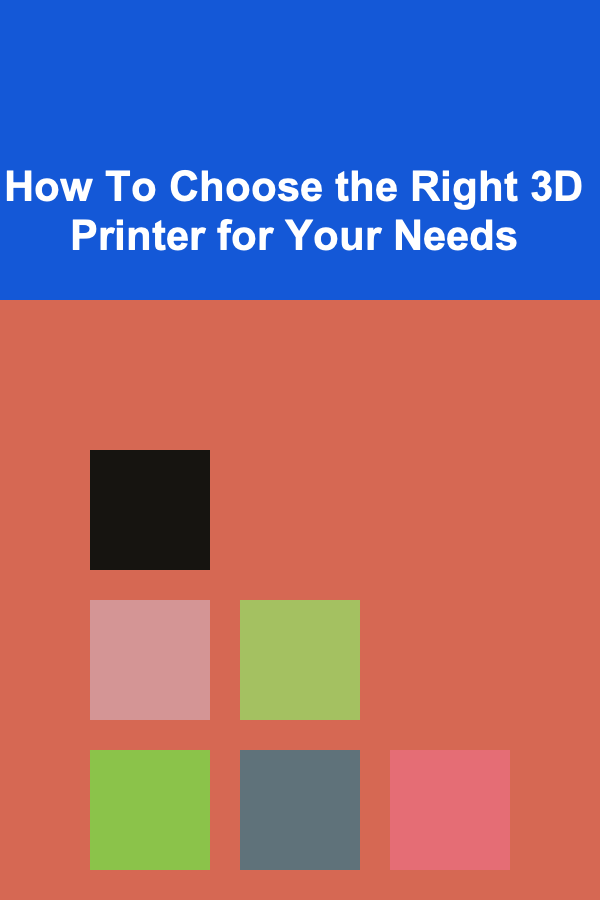
How To Choose the Right 3D Printer for Your Needs
ebook include PDF & Audio bundle (Micro Guide)
$12.99$9.99
Limited Time Offer! Order within the next:

3D printing, also known as additive manufacturing, has revolutionized the way we approach design, prototyping, and production. With an increasing number of 3D printers available on the market today, it can be overwhelming to figure out which one is best for your needs. Whether you're an artist, engineer, hobbyist, or small business owner, the right 3D printer can make all the difference in the quality, efficiency, and cost-effectiveness of your projects.
In this article, we'll explore the factors to consider when choosing a 3D printer, breaking down the essential aspects that will guide you toward the right machine for your specific applications. From understanding the different types of 3D printers to selecting the right features and materials, this guide will help you navigate through the complexities of 3D printer selection.
Understanding the Types of 3D Printers
Before diving into specifics, it's crucial to understand the various types of 3D printing technologies available. The type of printer you choose will depend heavily on what you plan to create, as each technology has its own advantages, limitations, and application uses. Below are the most common 3D printing technologies:
1. FDM (Fused Deposition Modeling)
FDM, or Fused Deposition Modeling, is one of the most popular and affordable 3D printing technologies. It works by extruding thermoplastic filament layer by layer to create a 3D object. The filament is heated and melted as it's deposited, and the layers solidify as the material cools down.
-
Advantages:
- Cost-effective, especially for entry-level printers.
- Wide variety of filament options (PLA, ABS, PETG, etc.).
- Relatively simple to use and maintain.
-
Disadvantages:
- Limited to lower resolution (though some high-end FDM printers can achieve better detail).
- May require post-processing (support removal, sanding).
Best for: Hobbyists, educational use, and basic prototyping.
2. SLA (Stereolithography)
SLA printers use a liquid resin that is cured layer by layer using a UV laser or light. This process creates high-resolution prints with excellent detail and smooth finishes. SLA printers typically offer superior accuracy compared to FDM printers.
-
Advantages:
- High precision and smooth finish.
- Excellent for fine details and intricate designs.
-
Disadvantages:
- Resin can be expensive and has a limited shelf life.
- Requires post-processing, including washing and curing the print.
- Often slower than FDM printing.
Best for: Professionals, jewelry makers, dental applications, and high-end prototyping.
3. SLS (Selective Laser Sintering)
SLS printers use a laser to sinter powdered material (usually nylon, metals, or ceramics) into a solid structure. Unlike SLA, SLS does not require support structures since the powder itself provides support during the printing process.
-
Advantages:
- No need for support structures.
- Strong, durable prints, especially with nylon or metal powders.
- Great for functional parts and low-volume production.
-
Disadvantages:
- Expensive machines and materials.
- Complex post-processing, including powder removal.
- Larger machines and materials may not be available for hobbyists.
Best for: Industrial applications, high-strength parts, and complex geometries.
4. DLP (Digital Light Processing)
DLP is similar to SLA in that it uses resin, but instead of a UV laser, it uses a digital light projector to cure each layer of resin. DLP printers tend to be faster than SLA printers because they cure the entire layer at once instead of point by point.
-
Advantages:
- Faster than SLA.
- High resolution and detailed prints.
-
Disadvantages:
- Limited resin options.
- Requires post-processing, such as cleaning and curing.
Best for: Rapid prototyping, small to medium-sized production runs, and highly detailed work.
5. Multi-Jet Fusion (MJF)
Multi-Jet Fusion is an advanced 3D printing technology that uses inkjet arrays to selectively apply fusing agents onto powder material. It can produce highly detailed and functional parts with high strength.
-
Advantages:
- High-quality, functional parts.
- Excellent mechanical properties.
- Suitable for both prototypes and production parts.
-
Disadvantages:
- Expensive equipment and materials.
- Limited availability of printers and materials for personal use.
Best for: Industrial applications, engineering prototypes, and functional prototypes.
6. LOM (Laminated Object Manufacturing)
LOM printers use thin layers of material (such as paper, plastic, or metal) that are laminated together and cut with a laser to form the object. This process is relatively quick and can be used with a variety of materials.
-
Advantages:
- Can use a wide range of materials.
- Relatively low-cost machines.
-
Disadvantages:
- Lower precision and surface quality compared to other methods.
- Requires post-processing to remove support structures.
Best for: Rapid prototyping and non-precise applications.
Key Factors to Consider When Choosing a 3D Printer
With so many 3D printing technologies available, how do you determine which one is right for you? Below are some critical factors to consider when making your decision:
1. Budget
Your budget will have a significant impact on the type of printer you choose. Entry-level FDM printers are relatively affordable, starting at around $200-$500. Mid-range printers with higher precision or advanced features may cost $1,000-$3,000. High-end industrial printers, such as SLS or MJF, can range from $10,000 to well over $100,000.
When setting a budget, also consider ongoing costs for materials (filament, resin, powder, etc.), maintenance, and potential software licenses.
2. Printing Size
The size of the objects you intend to print is a crucial factor. FDM printers typically have larger build volumes, meaning they can print larger objects. SLA and DLP printers, on the other hand, usually have smaller build volumes but are ideal for fine details. Be sure to select a printer that can accommodate your desired print sizes.
3. Material Options
Different 3D printing technologies support different types of materials, and each material offers unique properties, such as flexibility, durability, and heat resistance. If you're planning to print functional parts, consider a printer that supports stronger materials like nylon, polycarbonate, or even metals. If you're focused on aesthetics and detail, an SLA or DLP printer with a wide range of resins might be your best bet.
4. Print Speed
Print speed can vary depending on the type of printer. FDM printers can be relatively slow, while SLA and DLP printers tend to be faster, especially with smaller objects. Keep in mind that faster printing times often come with trade-offs in resolution and quality.
5. Print Resolution and Accuracy
The level of detail you need for your prints will dictate the printer's resolution. SLA and DLP printers typically offer much higher resolution and finer details than FDM printers. If you're creating detailed prototypes, jewelry, or miniatures, high-resolution printers are essential. For basic models or functional prototypes, a mid-range FDM printer may suffice.
6. Ease of Use
Some 3D printers are designed with user-friendliness in mind, making them suitable for beginners, while others require technical expertise. Look for printers with good documentation, reliable customer support, and easy-to-use interfaces. Features like automatic bed leveling, touchscreen controls, and simple setup processes can save you time and frustration.
7. Support and Community
Having access to a strong support system can be crucial, especially if you run into technical issues. Established brands like Prusa, Creality, and Ultimaker often have vibrant online communities where users can share troubleshooting tips and advice. Additionally, customer service and warranty options should be considered in case something goes wrong with the printer.
8. Post-Processing Needs
Many 3D printed objects require post-processing, such as support removal, sanding, or curing. Some printers have built-in features that make post-processing easier, while others may require you to do all of this manually. Consider how much time and effort you're willing to invest in post-processing.
9. Reliability and Durability
3D printers are complex machines, and reliability is essential if you plan to use the printer frequently. Look for models that have a proven track record of consistent performance and durability. Additionally, consider factors such as ease of maintenance, availability of spare parts, and warranty coverage.
10. Software Compatibility
Most 3D printers use proprietary slicing software to convert digital 3D models into instructions the printer can understand. Ensure that the printer you choose is compatible with your preferred design software or offers user-friendly slicing software.
Conclusion
Choosing the right 3D printer depends on many factors, including the type of prints you plan to create, your budget, the materials you want to use, and your technical expertise. Understanding the differences between technologies like FDM, SLA, and SLS will help you make an informed decision, as will considering key factors like print size, resolution, speed, and ease of use.
By thoroughly assessing your needs and carefully weighing the features and capabilities of various printers, you'll be able to find a machine that not only meets your expectations but enhances your 3D printing experience. With the right 3D printer, the possibilities are endless---whether you're building prototypes, producing functional parts, or simply exploring your creativity.
Reading More From Our Other Websites
- [Home Family Activity 101] How to Use Music and Dance as Family Bonding Activities
- [Home Renovating 101] How to Turn Your Basement into a Livable Space During a Renovation
- [Ziplining Tip 101] Safety First: What to Expect and How to Prepare for a Ziplining Adventure
- [Home Family Activity 101] How to Set Up a Family Fitness Tracker Challenge
- [Biking 101] Essential Tips for Beginners in Mountain Biking
- [Metal Stamping Tip 101] Choosing the Right Material and Finish for Small‑Batch Stamped Parts
- [Personal Finance Management 101] How to Overcome Financial Stress and Stay on Track
- [Organization Tip 101] How to Design a Functional Workspace for Your Hobby
- [Organization Tip 101] How to Organize Your Photography Gear in a Dedicated Space
- [Personal Care Tips 101] How to Avoid Over-Brushing and Protect Your Gums with the Right Toothbrush

How to Organize Fun Game Nights for the Whole Family
Read More
How To Use Organic Pest Control Sprays
Read More
How to Optimize Your Supplement Use for Weight Loss
Read More
How To Master Regular Expressions for Data Validation
Read More
Living a Life of Reason and Logic
Read More
How to Track Vision Insurance FSA/HSA Expenses Effectively
Read MoreOther Products

How to Organize Fun Game Nights for the Whole Family
Read More
How To Use Organic Pest Control Sprays
Read More
How to Optimize Your Supplement Use for Weight Loss
Read More
How To Master Regular Expressions for Data Validation
Read More
Living a Life of Reason and Logic
Read More